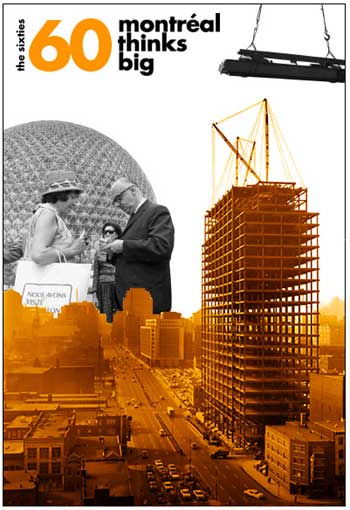During the 1960s, the massive scale of the changes that transformed Montréal made it an archetype of the great metropolises of the Western world. As host of Expo 67, Montréal asserted itself on the international scene as a city of the future. The CCA’s exhibition The Sixties: Montréal Thinks Big illustrates the processes that brought about these spectacular changes that were recognized all over the world.
The Sweeping Changes of the City
From gallery to gallery, the exhibition’s original models, photographs, press documents, and statements from influential figures, combined with film, video, and advertising from the period, describe – through the urban projects that were conceived as well as the architecture that gave them material form – the sweeping changes the city underwent and the excitement they generated.
Montréal’s Place in the World
"Part of the originality of The Sixties: Montréal Thinks Big lies in its contribution to the broad history of architecture and thinking about the city,” notes André Lortie, curator and designer of the exhibition. “If Montréal was unusual among cities in the West because of the massive scale of the changes that transformed its skyline, at the same time, it is archetypal of such phenomena in North America, South America, and Europe.” Exhibition visitors are thus made aware of the network of international exchange of ideas, and Montréal’s place within it during the period when Canada’s largest city was opening its horizons to the world.
Publication:
The exhibition is accompanied by a 208-page publication lavishly illustrated with colour and black-and-white images. This book, edited by André Lortie and published jointly by the CCA and Douglas & McIntyre Publishing Group, is available at the CCA’s Bookstore at a cost of $55. It will also distributed to other bookstores in Canada and abroad.
Around the Exhibition:
Site Specific_Montréal 04: 16 Photographs by Olivo Barbieri
20 October 2004 to 13 February 2005
Parallel to the main exhibition, this exhibition is presented in the CCA’s Octagonal Gallery. This exhibition comprises photographs commissioned by the CCA during the Summer of 2004, taken by helicopter, to show major projects of the city today.
Also not to be Missed:
The 2004-2005 James Stirling Memorial Lecture on the City
Border Postcards: Chronicles From the Edge by Teddy Cruz
Thursday 28 October 2004, at 6:30 pm, at the Canadian Centre for Architecture
Lecture by architect Teddy Cruz on geographies of conflict in the international border zone between San Diego and Tijuana. This lecture is the first James Stirling Memorial Lecture on the City, a program conceived in homage to architect James Stirling to create a forum for the advancement of critical perspectives on the role of architecture and design in the development of the urban environment. In collaboration with the Cities Programme of the London School of Economics and Political Science and in association with the Van Alen Institute, NYC.
|








